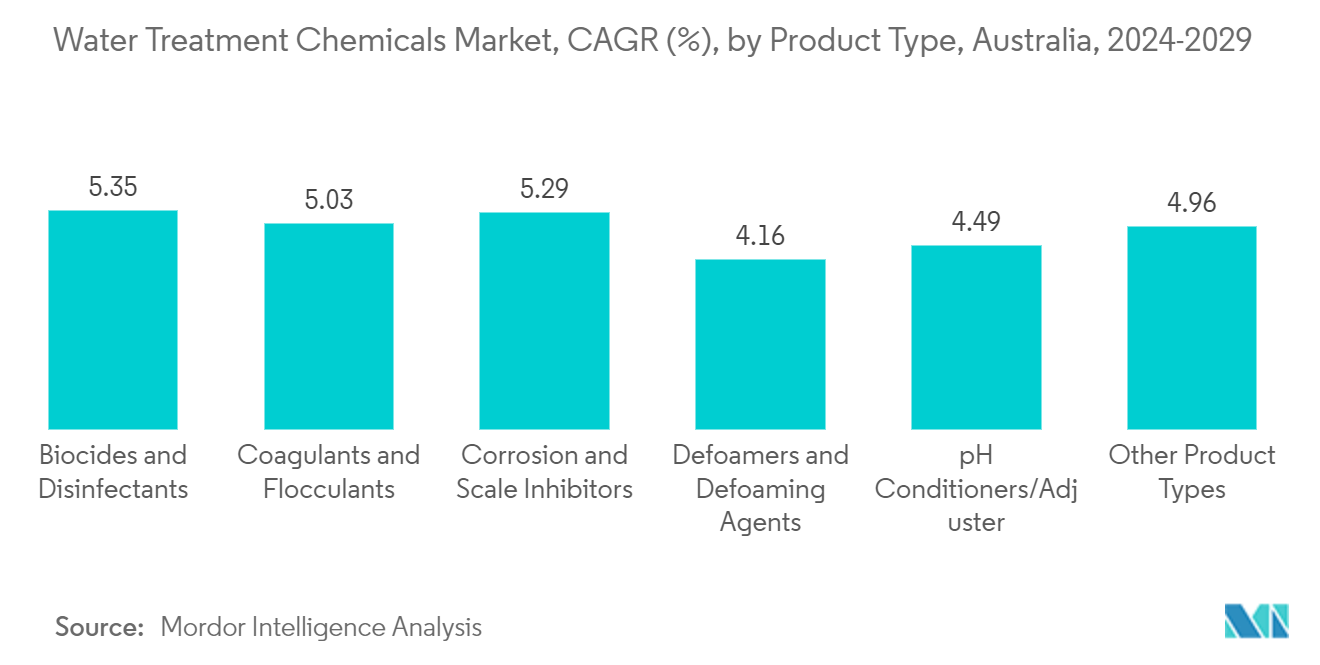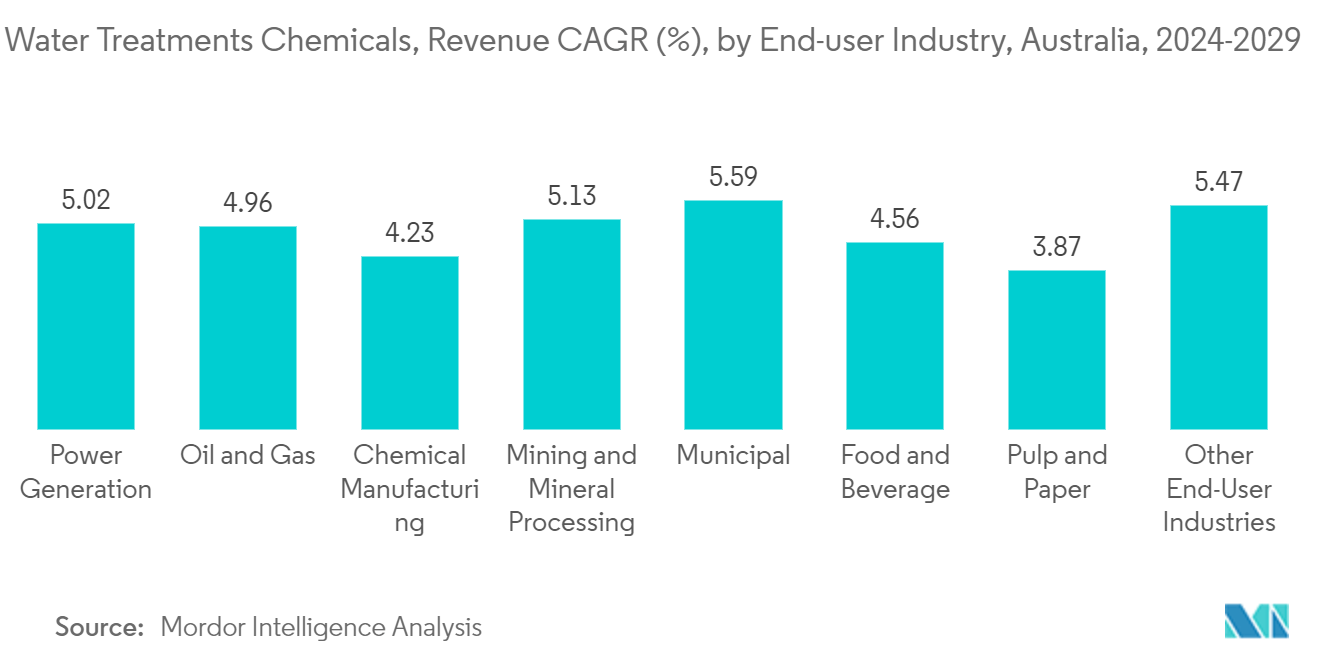Market Trends of Australia Water Treatment Chemicals Industry
Corrosion and Scale Inhibitors to Dominate the Market
- Corrosion inhibitors are general-purpose chemicals that deal with corrosion in boilers. Corrosion occurs when oxygen reacts with metallic parts in a boiler to form oxides. Corrosion affects the metallic parts of the boiler, thereby increasing the costs of energy and maintenance. Corrosion inhibitors form a thin barrier layer over the exposed parts of the boiler. Scale inhibitors are used to remove scales through chemical processes.
- Several types of corrosion inhibitors are used in water boilers. These include condensate line corrosion inhibitors, diethyl hydroxyl amine (DEHA), polyamine, morpholine, cyclohexylamine, and carbon dioxide corrosion inhibitors. A mixture of filming amines is used to prepare condensate line corrosion inhibitors. This can provide protection due to the presence of both high and low vapor/liquids.
- DEHA is a volatile compound that is also an oxygen scavenger and acts as a metal passivating agent. Polyamine can be used in both low and high-pressure boilers. Morpholine protects the boiler by increasing the pH level of the liquid. Cyclohexylamine is used in low-pressure boilers. Carbon dioxide corrosion inhibitor is used along with polyamine to control corrosion.
- The aforementioned inhibitors are also used in cooling water treatments to ensure metal protection and prevent metal loss. The absence of these inhibitors may lead to critical system failures in recirculating water piping, process cooling equipment, and heat exchangers. Corrosion inhibitors are added to treatment systems to protect metals by reducing the corrosion potential associated with the cathode and anode of the corrosion cell.
- The most serious form of corrosion occurs in cooling water treatment systems containing steel and copper alloys. Multi-phase processes, such as pretreatment, coagulation, flocculation, and corrosion control, occur during water treatment. Among these processes, the corrosion inhibitor is added after filtration to avoid fouling. As a countermeasure, corrosion inhibitors are added to prolong the service life of piping throughout a water distribution system.
- Furthermore, corrosion inhibitors are among the key chemicals used in the oil and gas industry. Corrosion inhibitors are the backbone of a strong asset integrity program that keeps equipment failure rates in check. They are used to safeguard wells, pipelines, tanks, compressors, and practically every other type of downhole or surface equipment. Oil and gas producers, transporters, and refiners would suffer greatly if corrosion inhibitors were inaccessible.
- The growing demand for solutions to avoid corrosion during processing across various end-user industries leads to the demand for corrosion inhibitors, which leads to the growth of the market studied.

Municipal End-user Industry to Dominate the Market
- The supply of pure water to households is one of the primary requirements for all governments. The rising scarcity of potable water, coupled with the growing population and increasing water demand, is driving the demand for the water treatment chemicals market in Australia.
- Municipal wastewater is water drained from toilets, showers, sinks, bathrooms, washing machines, dishwashers, and liquid industrial waste. It should be treated before it is released into the environment to avoid environmental damage and the spreading of harmful diseases.
- The major treatment technologies include preliminary treatment, primary and secondary treatment, tertiary treatment, biological nutrient removal (BNR), resource recovery, and energy generation.
- Australia's 2023-24 budget allocated significant funds to bolster the National Water Grid Authority, with USD 79.0 million earmarked over an 11-year span. Additionally, USD 197.1 million was reallocated over six years (starting 2023-24) to support three critical water infrastructure projects: the Northern Midlands Irrigation Scheme, the Sassafras-Wesley Vale Irrigation Scheme in Tasmania, and the Quality Water for Wannon project in Victoria.
- With a population of 26 million, Australia boasts a high water connectivity rate, with 94% linked to the primary water supply. The nation has approximately 300 urban water utilities, with a notable concentration. Notably, 22 utilities serve 70% of the population, while the remaining 200 serve the rest, a figure that is even lower than the customer base of Sydney Water, Australia's largest utility.
- Australia's annual water usage stands at around 26,000 gigaliters, translating to roughly 1.3 million liters per person. Despite being the driest inhabited continent and having access to less than 1% of the world's freshwater resources, Australia's water consumption ranks among the highest globally. This demand is further exacerbated by the country's growing population.
- Around 85% of the population currently has access to more than 700 community sewage treatment plants. Nearly half of these are based on biological filters, about 170 are lagoons, and 45 are based on primary treatment. Most new plants are implementing activated sludge processes.
- Hence, owing to the above-mentioned factors, the municipal segment accounts for a significant share of the water treatment chemicals market in Australia and is expected to fuel the growth of the market studied during the forecast period.


